Laminate on the wall in the interior of the kitchen

Laminate is a durable, effective and easy-care material. Traditionally, it is used to decorate the floor, and non-trivial to decorate the walls. Wanting to emphasize an extravagant taste, they experiment with panels in the kitchen, decorating one of the walls with them. The result is pleasing to the eye when you consider the pros and cons of laminate flooring and find the right method for installing the panels.
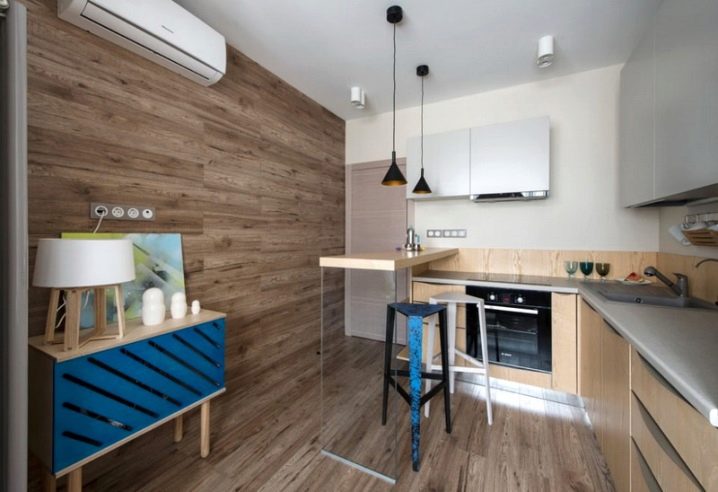
Advantages and disadvantages of registration
Wood paneling is a stylish and timeless option. It is appropriate in any interior decoration, looks elegant and harmonious, combined with other finishing materials. Natural wood is difficult to care for. If the washing wallpaper is limited to wiping with a damp cloth during general cleaning, then the wooden walls are polished every day. Therefore, instead of wallpaper and natural wood, laminate flooring is chosen for wall decoration, or laminate imitating rare and valuable wood species.


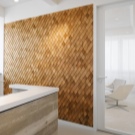


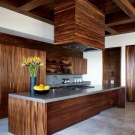
Advantages of using laminate flooring:
- looks like natural wood;
- durable and wear-resistant material due to the fact that it consists of several layers;
- not afraid of mechanical stress;
- abrasion resistant;
- the service life is on average a quarter of a century;
- the strips and modules have ideal geometric shapes and exact dimensions, therefore, after an easy installation, they create a solid canvas;
- does not require painstaking and daily care;
- is cheaper than lining or parquet.
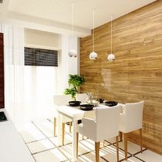
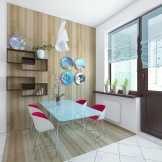
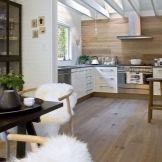
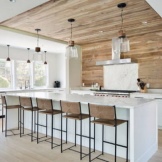
Laminate flooring has a drawback: it does not tolerate prolonged exposure to moisture. Therefore, they are not suitable for finishing balconies, basements and baths. For this reason, in the kitchen, a bad place for installing panels is the kitchen apron area, but there are moisture-resistant varieties that can be installed in any room.

Views
There are 4 types of laminated coatings: two of them are moisture resistant, and the other two are not.
- MDF panels. In their production, substandard wood is used, i.e. sawdust and small wood fibers, which are pressed with paraffin or lignin. Despite the low price, environmental friendliness and simple installation, MDF panels have a serious drawback - absorption of moisture from the air or hygroscopicity. This is due to its structure: the laminated surface is akin to varnished paper.

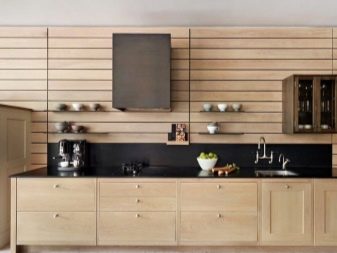
- Chipboard. This material is a board with a protective coating made of special decorative paper impregnated with melamine resins. Sanded chipboard is not attached to a wall without a lathing. She is afraid of moisture, like MDF, but does not deform at the first exposure. She is a denser and more durable material.
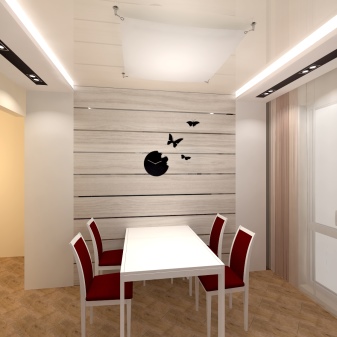
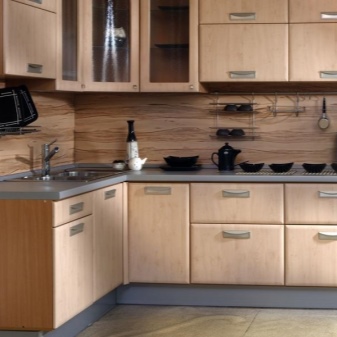
- Laminated hardboard or high density fiberboard - these are dense sheets with one decorative front side. Using it, they facilitate and speed up the completion of construction and finishing works. Walls, ceilings are sheathed with hardboard and internal partitions are made from it. It is distinguished by its low price, ease of cutting, installation and processing.
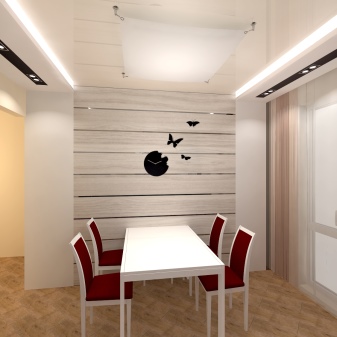

- Floor laminate Is a covering made of high density fibreboard. Its outer (top) layer is a laminated film. Kitchen aprons are made from it, as it is strong, durable and moisture resistant. It is used in the decoration of kitchens, taking advantage of the fact that it imitates any texture and pattern.
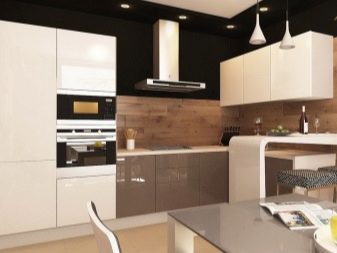
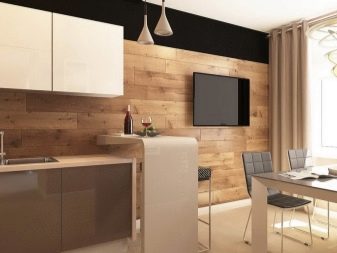
Panel Laying Methods
Not everyone has the money for a professional team that can cope with laminate walls in the kitchen. Often, the installation is carried out with your own hands, mentally preparing for a long and tedious procedure. In vain: beginners will cope in a day with finishing a wall from floor to ceiling 2.8 m high and three and a half meters wide. Before covering the wall with panels, choose a suitable method of laying the panels.
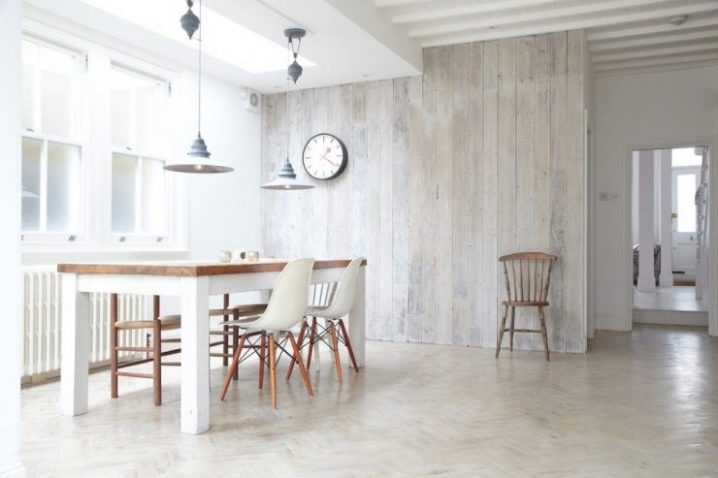
Horizontal
This method is difficult for beginners in matters related to apartment renovation. Having laid the board 1 m long, fix the plinth. It hides the joint and prevents the laminate from folding like an accordion. The folding problem is solved by alternating rows of short boards with long ones.

Vertical
Beginners prefer the vertical method. It is suitable for laying wall panels that are square, patterned or imitate parquet from different types of wood. Correctly place panels with a shift of the end, that is, randomly. Covering the wall with laminate in this way, they achieve a visual increase in the height of the ceiling in the kitchen. Lathing and liquid nails are used as fastening of the laminate.
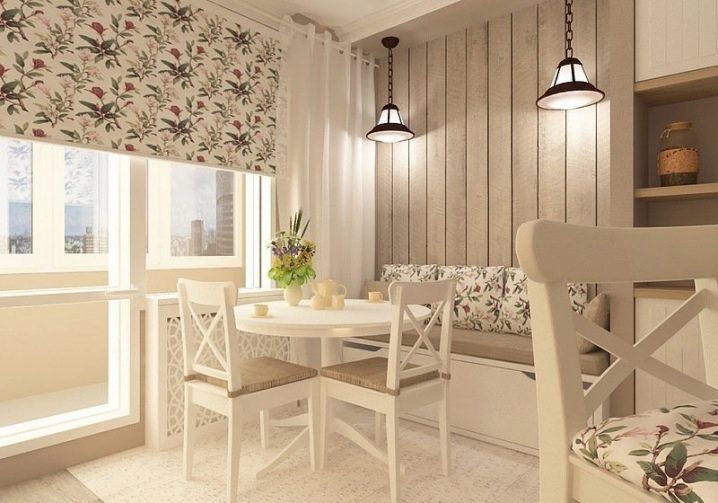
Pre-leveling of the wall is not required when fixing the laminate to the batten. This method is good for "Khrushchev" houses, where the sound and heat insulation of the premises suffers. If the kitchen is small, then this method will not work, because it will make it even smaller. The laminate is fastened to each other with locks, and for fastening to the crate, glue or a hidden form of the fastening element of the cleats is used. The structure is better held, on the one hand attached to the crate with screws / nails, and on the other, set on staples placed in the groove of the lamella.

Liquid nails are often used in laminate flooring. This method is easy to implement, since you do not need to assemble the crate for fixing the panels. So that they fit snugly to each other and the joints are not visible, they prepare the wall, having previously aligned and dried. Having collected part of the wall on the floor, they glue it to the prepared surface.
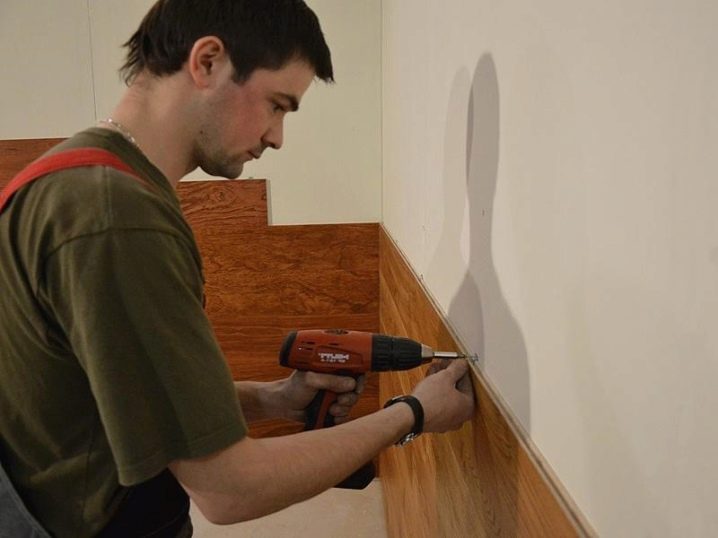
In no case do they "sit" the laminate on drywall and do not glue the resulting structure to the wall. Otherwise, it will collapse a few days after installation due to its heavy weight.
Design options
Laminate wall decoration is a non-standard solution for the kitchen. A kitchen apron with wood sheathing performs a protective function and acts as a decorative element. Moisture resistant types (floor and laminated hardboard) allow you to fulfill your plans and not face an unpleasant consequence in the form of deformation. If you play with color and decorate the wall in contrast with other finishing materials, you can distinguish between the cooking and eating areas.
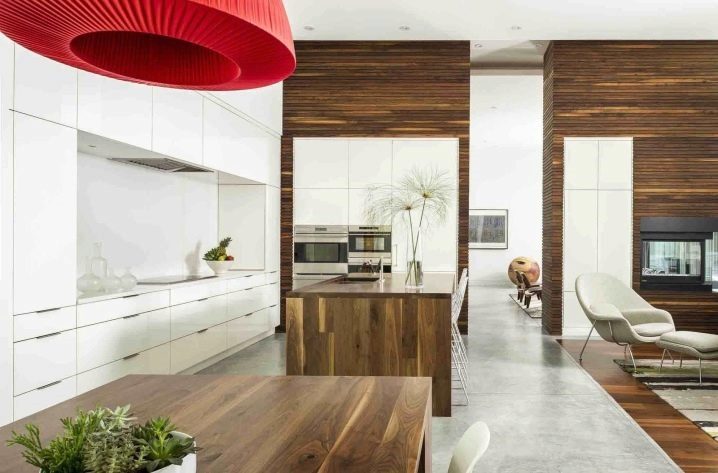
White
Cold-washed bleached laminate is a great solution for small kitchens. He endows them with freshness, neatness, accentuated cleanliness. They gain airiness and spaciousness with it.
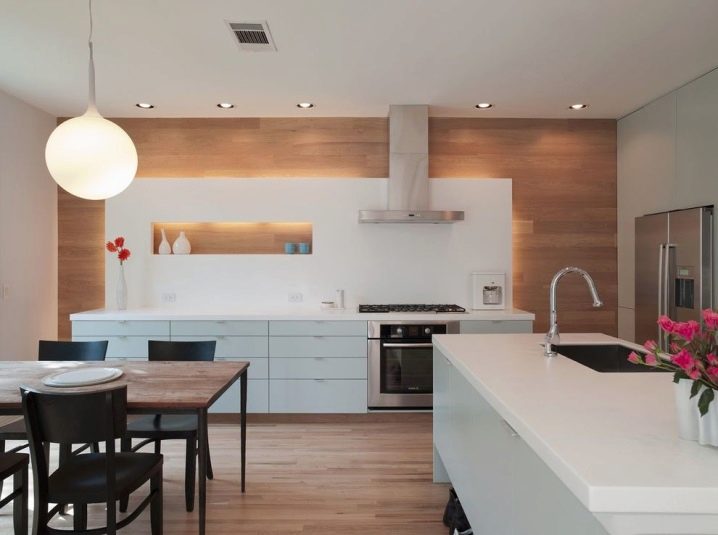
Caring for a whitewashed board is simple, like any other: the dirt is washed off with a cloth soaked in water and detergent.
Black
Glossy hi-tech is the choice of young married couples who for the first time equip a cozy nest. A style in design and architecture that originated in the 60s. XX century, assumes the presence of modern technology in the kitchen. To emphasize its modernity, one cannot do without walls decorated with black laminate. The "neighborhood" of technology and this finishing material enlivens the interior and warms in chilly autumn and spring days.
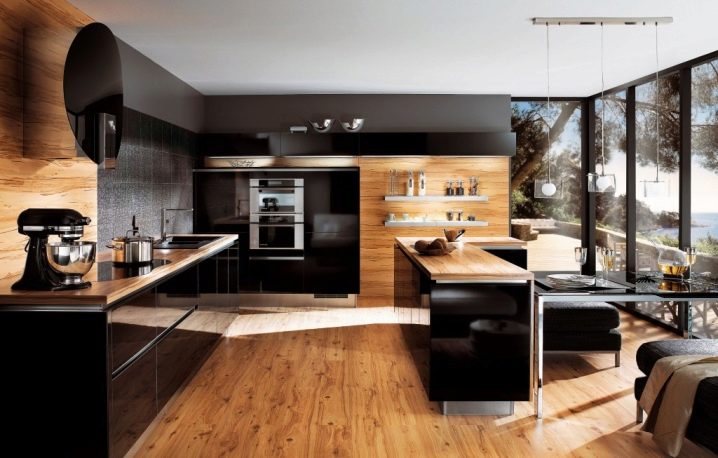
Gray
If you decorate the interior in a bright blue color (or you bought furniture of this color for the kitchen), then the gray panels neutralize its power. The idea is a losing one if the kitchen is small and there are no mirrors or glass surfaces in it.
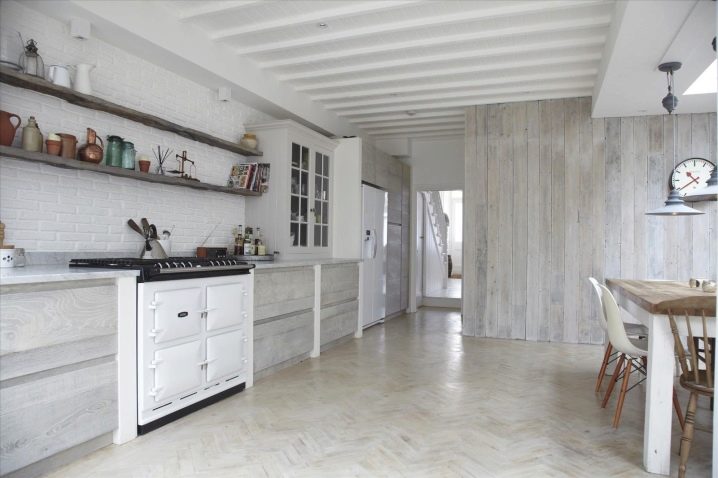
Yellow, red, green
Laminate, painted in such bright and saturated colors, looks advantageous against the background of snow-white cabinets and walls. If there is a small drawing on it, you get an interesting visual effect.If the minimalism style is chosen for the decoration of the kitchen in the apartment (the apron over the working area is allocated with a laminate laid with a "herringbone") and they are content with this, then they experiment in dachas and in country houses. For the kitchen, buy a single-level U- or L-shaped set. In the first case, a fireplace (including a decorative one) is placed near the free wall and sheathed with a laminate. In the second case, the selected corner will be the corner between the two walls, finished with laminated wood-like panels. So that they do not look pretentious, laminate of the same color is laid on the floor or furniture is bought in the same color scheme.
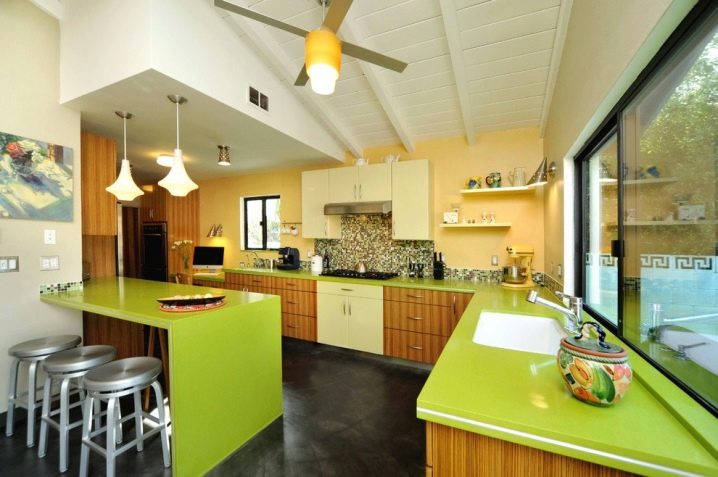
Designers combine boldness and practicality in one extravagant solution. They finish all surfaces, including walls and ceilings, with the same laminate in appearance and color. He will be everywhere: above, below, on the walls. Experimenting with the color of the decor and kitchen furniture, they avoid "draining" the space.
Advice
Whatever design solution you choose for wall decoration in the kitchen, the main thing is to achieve harmony with the main decoration. The tips below will help you with this.
- Laminate in dark colors looks elegant against the background of light wallpapers and plain walls.
- Laminate panels in linen, milk, cream and other colors look great against the backdrop of dark plastered walls.
- The wall is trimmed with a dark laminate, along which the eating area will be located.
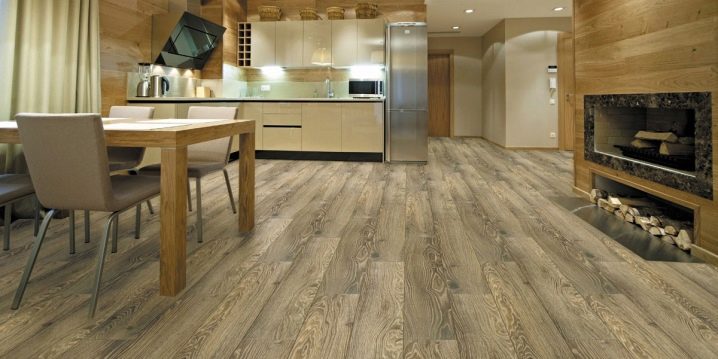
Laminate is used in the decoration of rooms for any purpose. Along with its usual placement on the floor, it is used to decorate the walls in the kitchen. They trim a kitchen apron or a free wall. It doesn't matter where it will be installed. It should be in harmony with the facade of the kitchen unit. They are not afraid of splashes of grease, as they are easily washed off if you wipe the surface with a cloth moistened with detergent.
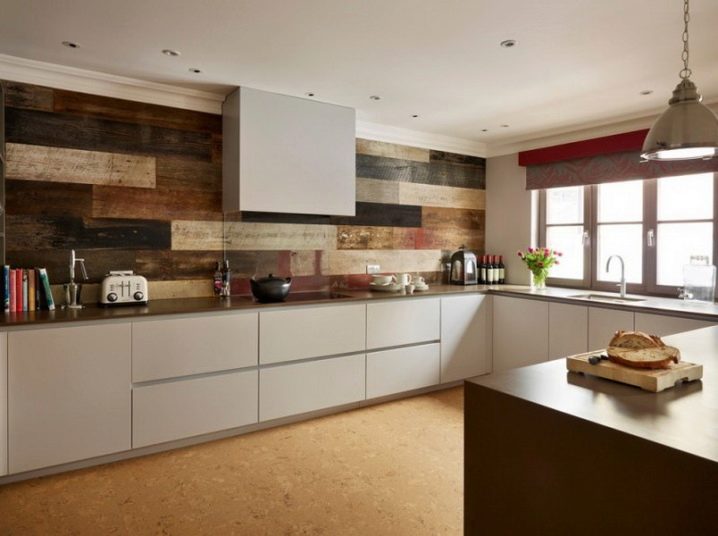
For information on how to choose a laminate for the kitchen wall, see the next video.













The comment was sent successfully.